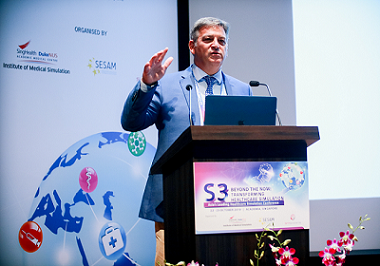Utilizing an in-Unit Simulation Station for Low Fidelity High Frequency Training
Introduction:
At our academic children’s hospital, there are over 170 total physicians, nurses, nurse practitioner, and respiratory care staff who can attend a newborn delivery, resulting in billions of different team permutations that could attend a neonatal resuscitation in the delivery room at any given time. Additionally, there are over 60 different providers who could manage the airway, and so the opportunity to perform mask positive pressure ventilation (MPPV) and intubation is infrequent. As a result, our teams are unfamiliar with one another, lack behavioral skills necessary to function as high performing team, and frequently perform MPPV incorrectly. Review of recorded resuscitations showed that MPPV in the delivery room was performed correctly 11% of the time in an 8-month period.
We demonstrate how an in-unit simulation station can facilitate practice of technical skills each shift and prior to complex resuscitations.
Description:
We created a NICU-based Simulation Station with a radiant warmer, neonatal code cart, T-piece resuscitator, face masks and intubation supplies for term and preterm manikins, two low fidelity full-term manikins, one low fidelity preterm manikin, and a respiratory function monitor. The Simulation Station is in the NICU and is intended to be used by all team members who attend deliveries. Delivery team huddles occur twice daily (once per shift) at the simulation station. Team members stand at the radiant warmer, rehearse their roles, practice using resuscitation-specific briefing checklists, and visualize themselves in a resuscitation together. Team members who will manage the airway during deliveries complete a MPPV exercise and intubation exercise at the beginning of each shift. For anticipated complex deliveries, teams can conduct just-in-time training to practice technical and behavioral skills prior to the resuscitation.
The Simulation Station opened on March 18, 2024. MPPV performed during recorded resuscitations from our delivery rooms was analyzed for a total of 17 months before and after the opening of the simulation station. The analysis focused on rate, iT, head position, and mask hold.
Discussion:
Our NICU utilized an in-unit Simulation Station to adopt high frequency, low fidelity simulation training that strengthens the technical and behavioral skills of our resuscitation teams. Having the station centrally located allows it to be utilized frequently for short bursts of time by all NICU staff. The training has been positively and quickly adopted by all team members as demonstrated by the usage data as well as by verbal reports. MPPV data shows that frequent skills training has increased the amount of time this skill is performed correctly.This Simulation Station and its usage can be replicated in other areas of healthcare to optimize relevant skill acquisition.
© 2025 SingHealth Group. All Rights Reserved.














